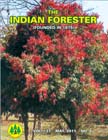Economic Analysis of Agroforestry Model Adopted by Tribal of Orissa : India
DOI:
https://doi.org/10.36808/if/2011/v137i5/12889Abstract
Trial has been framed to examine the economics of growing teak and cashew nut along with upland paddy in four combinations. The data trends up to 7 years of plantation were extrapolated to project the economic profit using standard economic analysis methods to interpret the benefits of various tree crop systems. The prediction has been done at 15th and 45th year (rotation age) at 7% and 15% discounting rate. The Net Present Value (NPV) predicted at rotation was found highest in land use with Agri-silviculture (teak + paddy) at 7% rate Rs 7,24,699/ha where as at 15% rate of discounting the highest NPV was observed in Agri-horticulture (cashew nut + paddy) Rs 45,255/ha, followed by Silvi-horticulture, Agri-silviculture and lowest in Agri-silvi-horticulture Rs 27,289/ha. The benefit cost ratio (BCR) was found higher 3.64 and 1.98 respectively at the 15th year in case of Silvi-horticulture (teak + cashew nut) at two extreme of discounting (7 and 15%) than that found in the other three agroforestry combinations. At rotation age of 45 years the highest BCR (6.33 and 2.64) was also found in Silvi-horticulture (teak + cashew nut) combination at 7% and 15% discounting respectively and it was found lowest in cashew nut+ paddy (4.42) at 7% and teak + cashew nut + paddy (1.78) at 15%Downloads
Download data is not yet available.
Downloads
Published
2011-05-01
How to Cite
Singh, P. K., Das, P. K., & Quli, S. M. S. (2011). Economic Analysis of Agroforestry Model Adopted by Tribal of Orissa : India. Indian Forester, 137(5), 535–543. https://doi.org/10.36808/if/2011/v137i5/12889
Issue
Section
Articles
License
Unless otherwise stated, copyright or similar rights in all materials presented on the site, including graphical images, are owned by Indian Forester.





